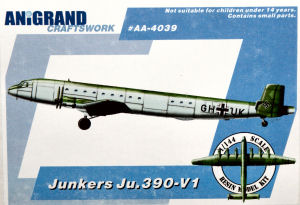
Anigrand Craftswork 1/144 Ju 390 V1 Kit First Look
By Michael Benolkin
| Date of Review | October 2009 | Manufacturer | Anigrand Craftswork |
|---|---|---|---|
| Subject | Ju 390 V1 | Scale | 1/144 |
| Kit Number | 4039 | Primary Media | Resin |
| Pros | There are five models in this release | Cons | Fragile landing gear, individual propeller blades must be built up |
| Skill Level | Intermediate | MSRP (USD) | $102.00 |
First Look
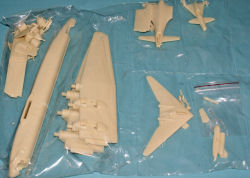 |
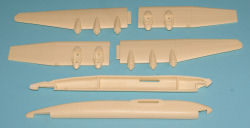 |
 |
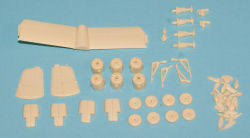 |
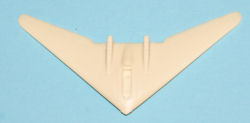 |
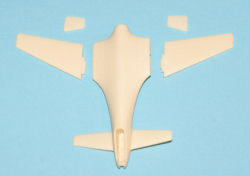 |
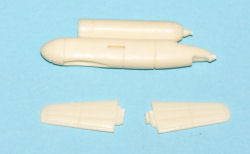 |
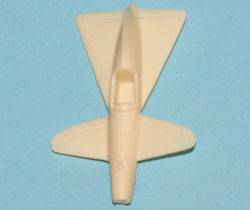 |
 |
The Ju 390 was a seriously scaled up version of the Ju 290 bomber/maritime patrol aircraft. Where the Ju 290 was a four-engined aircraft that was nearly 94 ft long with a wingspan of 137.75 ft, the Ju 390 was a six-engined aircraft that was over 112 ft long with a 165 ft wingspan. In contrast, a B-29 was 99 feet long with a 141.25 ft wingspan.
The Ju 390 series was designed for extremely long range operations filling a contingency that was forseen by the US leading to the development of the B-29, B-32, and B-36 in the early days of World War Two. Germany had focused aircraft development on fighters as well as light and medium bombers leaving a significant hole in its long-range maritime interdiction capabilities.
As the war progressed, Germany knew it had to strike at the American homeland if it wanted to shift America's military might from offensive to defensive. A series of Amerika Bomber aircraft were commissioned in 1942 for the role including the Me 264 (that bears an interesting likeness to the B-29) and the Ju 290, with the even heavier Ju 390 following suit. While only two examples were built, the Ju 390C was intended to be the long-range bomber variant and would have likely become one of Germany's atomic bombers had circumstances been different.
This kit is actually five kits in one box. The five subjects in this box are:
- Junkers Ju 390 V1
- Horton VII
- PA.22
- Bv P.175
- Hs P.87
The first image illustrates the usual fine job of packaging of each kit and clear parts to get you a complete and undamaged model. The bag is heat-sealed into compartments to keep the individual small kits separate and the major sections of the main kit from damage.
The the next image, you can see the hollow-cast fuselage and wings. Anigrand did a really nice job on the engineering of this kit as the wing halves go together nice. You can see in the second image how the landing gear fairings are molded into the lower wing halves and snuggle under the round nacelle fairings on the upper wing halves. The third photo shows the nice tight fit of the upper and lower wing halves, especially around the curved joints.
The fourth image shows the remainder of the kit parts including the tail section, four main landing gear struts and a tailwheel strut. Each main gear strut mounts two wheels, so this monster gets nine wheels to keep the grass stains off the belly. The main landing gear doors are molded closed but are easily cut in halves to pose the model with the gear down. The pile of parts to the right are the propeller spinners and all of the propeller blades that will need to be mounted. I believe many folks are opting to build the aircraft sans propeller blades as if the engines are running.
The next kit in the stack is the Horton VII concept aircraft that would later lead to the Ho 229. This was the aircraft concept that inspired Jack Northrop to experiment with the flying wing concepts and would ultimately lead to the B-2 Spirit.
Next up is a kit that would be seriously cool in 1/48 scale - the Henschel P.87. This was a paper concept for a strike aircraft that was powered by a counter-rotating pusher propeller. It was large enough for a crew of 3-4 and was one of the tail-first concepts that didn't get off the drawing boards.
Next is the Blohm & Voss P.175 Bordjaeger. This was designed as a parasite fighter and didn't have landing gear. With the guns mounted on either side of the belly-mounted engine, it would not have been fun to keep that early engine lit while ingesting gun gasses...
The final kit in this set is the Payen Pa 22 which was supposed to be a ramjet-powered testbed, but the engine wasn't available in time so flight tests were completed with a piston engine instead.
The kit provides two sheets of decals to provide sufficient markings for all five aircraft.
There are some interesting subjects in this box and clearly the most impressive of the lot is also the headliner - the Ju 390 V1. Even in 1/144 scale, this isn't a small model but it is certainly distinctive and will go well with the four other designs that never quite made it to prime time.
My sincere thanks to the US importer, Nostalgic Plastic for this review sample!







